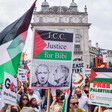Rights and Accountability 8 July 2017
The family obeyed the order, evacuating the three-story building as their neighbors gathered round.
About an hour later, a drone-fired missile hit the solar water tank on the building’s rooftop.
This tactic is euphemistically called a “roof-knock” by the Israeli military. It entails striking a building with a small missile without an explosive warhead as a precursor to the use of a heavier bomb.
After the “roof-knock,” the Kaware family and their neighbors began to ascend to the roof, hoping their presence would deter Israel from targeting the home.
Six children killed
Four of them had made it to the top of the building when it was hit by a heavy missile fired from an F-16 warplane. The roof collapsed, killing eight people, all but two of them children. One of the 28 persons who were injured in the strike died of his wounds days later.
The Israeli military claimed that operational error caused unintended civilian deaths when it targeted the Kaware family home, where a senior figure in Hamas’ military wing was living. The bomb was in the air when the family started returning to the home, a senior air force commander explained at the time, and there was no way to divert it.
Operational error or not, the targeting of residences belonging to Hamas figures is a violation of the laws of war.
“Treating these homes as legitimate targets is an unlawful, distorted interpretation of the concept, resulting in harm to civilians, whom this body of law is intended to protect,” the Israeli rights group B’Tselem stated.
B’Tselem argued that given the crowd assembled outside the Kaware home, the army did not take precautions to prevent harm to civilians when it fired the deadly missile.
On the same day that the Kaware family home was targeted, Israel bombed that of the Hamad family in northern Beit Hanoun without warning, shortly after the family had gone to bed. Six members of the family, including a 16-year-old girl, were killed.
Like in the case of the Kaware family, Israel attempted to justify its targeting of the Hamad family home by saying it belonged to an activist with the armed wing of Islamic Jihad.
By Israel’s logic, incompatible with international law, an apartment block in Tel Aviv would be a legitimate bombing target because an army general lived there, or Tel Aviv itself because Israel’s military is headquartered in the city center.
Killed at home
The massacres at the Kaware and Hamad family homes took place on the first day of Israel’s 51-day military offensive, which would claim more than 2,200 Palestinian lives, the overwhelming majority of them civilians. A quarter them were at home when they were killed.
What happened to the Kaware and Hamad families would happen to many others. At least 142 families in Gaza lost three or more members during an attack on a residential building. Some – like Ibrahim and Taghreed al-Kilani, along with their five young children and four of Taghreed’s siblings – were wiped out completely.
The stories of 53 of those families have been documented and beautifully presented as part of the Obliterated Families multimedia project, found at obliteratedfamilies.com.
A 14-minute film by Anne Paq and Ala Qandil, produced as part of the project, and which can be viewed at the top of this page, pays tribute to these families.
In the film, survivors describe the moments before and after the Israeli strikes which would take the lives of their children, spouses, parents, siblings, grandparents, neighbors.
“It’s as if you’re carrying a bag of fruit and it gets torn, and all the fruit scatter on the ground,” Nabil Siyam, a taxi driver from Rafah, says of finding his wife and children’s bodies in shreds.
He is shown sitting with his sole surviving child on his lap as they flip through an album of photos of their lost loved ones.
Other families’ photos show children playing with bubbles in a bathtub, sitting for school portraits, or in graduation caps.
In one scene, a man rubs the head of his kindergarten-age son as he describes the boy being taken to the morgue, mistaken for dead until a neighbor noticed the child breathing from under the dust and mud that caked his face.
Another father describes how his daughter, the only survivor of the bombing which killed the rest of his children, refused to go to school afterwards.
“For 50 days after the bombing, I went with her to school and sat with her at the same desk,” he says.
The survivors are not optimistic that they will see justice.
“The world is unjust. Otherwise it wouldn’t sit watching for 51 days while Gaza was being bombed,” one man says.
The short film is titled Gaza: A Gaping Wound, suggesting that healing cannot begin, so long as accountability is out of reach.






Comments
The Obliterated Families project
Permalink Carol Scheller replied on
Thank you for writing about this unique and vital reminder that goes straight to the heart of what cannot and must not be forgotten. Anne Paq showed her film and answered questions in Bern, Switzerland, a short time ago before returning to Gaza to work on a new projet for which I hope she will get strong support.
Please tell that poor man we
Permalink Ruth orrell replied on
Please tell that poor man we marched for him in London in order to try to stop the continuation of this atrocity. I hope it gives him some comfort to know that some of us did not sit by and ignore.